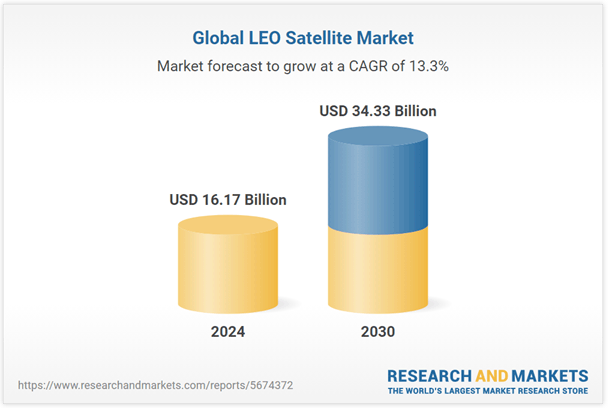Global LEO Satellite Market Forecast 2024-2030
Dublin, Ireland, August 14, 2024--The Low Earth Orbit (LEO )Satellite Market grew from US$ 14.33 billion in 2023 to US$ 16.17 billion in 2024. It is expected to continue growing at a CAGR of 13.28%, reaching US$ 34.33 billion by 2030 according to new research from Research and Markets.
This proximity to Earth allows LEO satellites to provide lower latency communication and higher speeds, making them particularly advantageous for telecom services, earth observation, and various scientific endeavors. The expanding use of LEO satellites is largely driven by advancements in satellite miniaturization, reducing launch costs, and increasing demand for high-speed internet access in remote areas. Furthermore, the global push for improved global connectivity and the need for real-time earth monitoring for climate and disaster management support this expansion. However, space congestion and the potential for orbital debris pose significant challenges, as the increasing number of satellites can lead to crowding and an elevated risk of collisions. Moreover, the relatively short orbital lifespan of LEO satellites necessitates frequent launches to replace or augment constellations, potentially increasing operational costs and environmental impact. Addressing these challenges requires enhancing satellite durability and lifespan, developing more sustainable launch technologies, and implementing comprehensive space traffic management practices to mitigate collision risks and space debris. Emerging technologies such as satellite-based quantum communication and on-orbit satellite servicing present new avenues for growth and innovation in the LEO satellite sector.

Regional Insights
In the Americas, there is a robust ecosystem for LEO satellite production and deployment, driven by a combination of ambitious private sector players and supportive policy frameworks. This region leads in leveraging LEO satellites for broadband internet services, demonstrating a high level of technological innovation and commercial application. The APAC region is characterized by a diverse use case scenario ranging from telecommunications to Earth observation, with China and India significantly investing in their space capabilities to enhance regional connectivity and surveillance. APAC's production landscape is marked by state-led projects and an emerging private sector, indicating a balanced growth trajectory. In contrast, the EMEA region presents a nuanced picture where the European Space Agency (ESA) and individual countries, including France and Germany, play a crucial role in defining the region's engagement with LEO satellites. The focus in EMEA is more evenly split between scientific research, commercial services, and security applications, reflecting the diverse prioritization of space technology in the region. Additionally, there is a strong emphasis on international collaboration within EMEA, evidenced by various partnerships and consortia aimed at ensuring equitable access to satellite technology.
Market Dynamics
The market dynamics represent an ever-changing landscape of the LEO Satellite Market by providing actionable insights into factors, including supply and demand levels. Accounting for these factors helps design strategies, make investments, and formulate developments to capitalize on future opportunities. In addition, these factors assist in avoiding potential pitfalls related to political, geographical, technical, social, and economic conditions, highlighting consumer behaviors and influencing manufacturing costs and purchasing decisions.
Market Drivers
- Increased demand for global high-speed internet connectivity
- Government investments in LEO satellites for defense and security activities
- Emphasis on utilizing smaller and reusable satellites
Market Restraints
- Issues associated with space debris due to satellites
Market Opportunities
- Emergence of satellite-based IoT platforms and innovations in LEO satellites
- Potential of LEO satellites for enhanced disaster management and monitoring
Market Challenges
- Technical and operational limitations of LEO satellites
Market Segmentation Analysis
- Component: Development of advanced payload systems to support enhanced LEO satellite deployment
- Application: Exponential potential of LEO satellites for earth observation activities
Key Company Profiles
The report delves into recent significant developments in the LEO Satellite Market, highlighting leading vendors and their innovative profiles. These include AAC Clyde Space AB, Airbus S.A.S., Ariane Group, Astranis, Honeywell International Inc., Kepler Communications, L3Harris Technologies, Inc., Lockheed Martin Corporation, Millennium Space Systems, Inc. by The Boeing Company, Mitsubishi Electric Corporation, Moog Inc., Northrop Grumman Corporation, OHB SE, OneWeb by Eutelsat Group, Planet Labs PBC, Pumpkin Inc., Rafael Advanced Defense Systems Ltd., Raytheon Technologies Corporation by United Technologies Corporation, SCOUT Space Inc., Sierra Nevada Corporation, SpaceX, Spire Global, Inc., Surrey Satellite Technology Limited by Airbus SE, Thales Group, and Vyoma Space.
For more information go to: https://www.researchandmarkets.com/reports/5674372/global-leo-satellite-market-by-component





